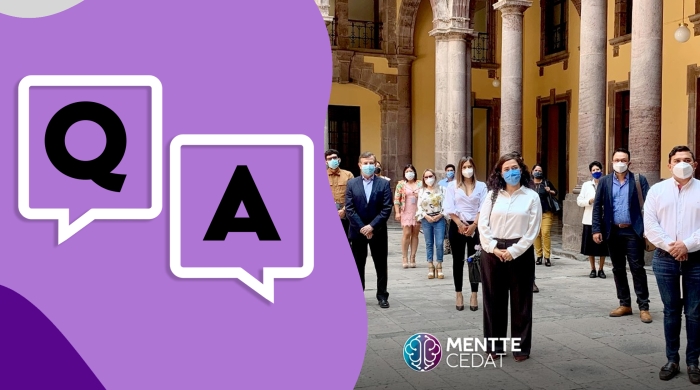
Dr. Carly Baetz is Assistant Professor in the Department of Child and Adolescent Psychiatry at NYU Langone School of Medicine. Her work examines the impact of trauma on justice-involved youth and the effectiveness of implementing trauma-informed services for youth, families, and staff in juvenile justice settings. She is a member of NYU Blueprints for Progressive Change in Juvenile Justice, an interdisciplinary working group through IHDSC. On the Ground discussed with her the importance of trauma-informed approaches to working with adolescents and young adults in the juvenile justice system.
Trauma-informed approaches are being discussed in multiple child-serving systems across education, mental health, welfare and justice, as central approaches to providing effective care. Can you tell us what “trauma-informed” means in this context and why it’s increasingly important?
Trauma has the potential to impact everyone involved in child-serving systems—the youths, their families and the staff who provide care. That’s why it’s so important that everyone working in these systems is able to recognize the signs and symptoms of traumatic stress and respond to situations in ways that resist re-traumatization. This philosophy should also be embedded at the organizational level so policies and procedures include trauma-informed principles.
Trauma-informed care may look different depending upon the system and setting, but the overarching framework remains the same and requires that we shift our lens from focusing on “what’s wrong” with a particular youth or family to “what happened” to that youth or family. With this seemingly small perspective change, we expand the opportunities for providers to help youth heal rather than inflict further trauma on them. Changing focus also enables systems to operate from a more strengths-based perspective, rather than concentrating attention on each individual’s deficits.
The majority of youth who are involved in the juvenile justice system have experienced trauma, including community violence, abuse and neglect, and racial trauma and discrimination. Being in the system itself can also be a traumatic experience. In fact, some of the behaviors labeled as “defiant” or “aggressive” that might bring a youth to the system’s attention are actually untreated traumatic stress reactions. If we don’t consider how trauma might be impacting that youth, we are missing a large part of the picture and a critical opportunity to provide services that could change that child’s trajectory. This is why it’s important for every point of contact in a system to be trauma-informed.
We know that there’s a lot of enthusiasm about trauma-informed training. For example, staff have developed a shared vocabulary around these issues. What have you learned about the possibilities of trauma-informed training? When and how does it work best?
Trauma-informed training can be an effective way to provide foundational information about trauma and its impact on youth and families. It also helps front-line staff realize the impact that vicarious trauma can have on them.
The concept of trauma-informed care can be a major culture shift for juvenile justice settings. When it’s done right and staff can see how it will benefit them, training can help everyone—from leaders to middle management to front line staff— start from the same place when they’re working with youth.
But training alone is not enough to enact a cultural change or even ensure that staff will use the skills they’ve learned. The organization has to commit to integrating trauma-informed skills into the setting’s day-to-day practice and overarching culture. Ideally, training is followed by ongoing coaching to help staff apply their new skills to their work with youth and families. I’ve also learned the importance of first training an organization’s leadership, as those are the people who must be on board for staff instruction to be successful.
An organization’s staff turnover rate also makes trauma-informed training challenging, as you need a core skilled group in the facility for any training to take hold. We try to use a train-the-trainer model to integrate trauma-informed training into many settings, but this approach can’t work when staff attrition keeps erasing those skills from the organization’s workforce. During the pandemic we’ve shifted to virtual training for detention staff, which has been useful in many ways but also presents different challenges. For example, virtual training can be more convenient for participants if they have carved out time to attend within their work day, but it can also be more challenging to create interpersonal connections and keep participants engaged on a virtual platform.
What are the potential limitations to trauma-informed approaches?
Although we know so much more than we did even a few years ago, there are still many gaps in our understanding of what trauma-informed approaches are effective in different juvenile justice system settings. We have a general framework with key components, but how this translates into practice in certain settings is still being established. For example, the National Child Traumatic Stress Network has identified partnerships with youth and families as one of the essential elements of a trauma-informed juvenile justice system, but many settings are still figuring out what this looks like on the ground. We also need to make sure that we’re not over-pathologizing youth when considering how trauma may be impacting their functioning.
There also needs to be more emphasis on understanding, acknowledging and addressing burnout and secondary traumatic stress among front line staff, as trauma-informed approaches for youth and families will have little impact in residential settings if the staffs’ needs aren’t being met. At the same time, the impact of racial and historical trauma on youth and families is sometimes missing from trauma-informed interventions, but this is a critical part of trauma-informed care. For example, many trauma-informed screening measures do not routinely ask questions about race-based traumatic stress, which effects almost all of the youth that we see in the juvenile justice system. Finally, trauma-informed approaches take time, thoughtful planning, a lot of buy-in, and ongoing collaboration between partners. Obviously, this can be a challenge for a system or setting that is in crisis and operating in survival mode.
This project has partnered closely with New York City Administration for Childrens’ Services. How has this partnership changed your approach to, or understanding of trauma-informed interventions?
Our work involves the provision of trauma-informed training to staff in juvenile detention facilities and trauma-informed services to youth in detention and their families. This work wouldn’t be possible without our partnership with ACS. One of the things I’ve learned through this experience is how important it is to be able to work closely with partners, both on the ground and in higher-level administration. An intervention that is effective in one setting is not always feasible in another, and sometimes it makes sense on paper but not from the perspective of the people doing the work on the ground.
So, it’s critical to work closely with partners at all levels to make sure that the intervention works towards the agency’s objectives but also in practice for the betterment of youth. Collaboration is always the best approach. We may be coming into a setting as experts in trauma-informed care, but the staff and leaders are experts in the work they do; everyone needs to work together for any trauma-informed intervention to be effective and sustainable.
What intersections do you see in your work between trauma, mental health, and the twin pandemics of COVID-19 and racial injustice? What do you see as critical for juvenile justice-involved youth and staff to heal and move forward?
The COVID-19 pandemic has highlighted and further exacerbated inequities that have always existed in the mental health and juvenile justice systems. COVID-19 has certainly been traumatic for everyone, but Black and Latinx youth have been disproportionately impacted in so many ways. For example, Black and Latinx youth in New York are twice as likely to have experienced the death of a caregiver due to the virus compared to white youth, yet they are less likely to have access to behavioral health services in the community.
The pandemic has further reduced access to in-person mental health services and other supports, such as schooling, mentoring, and other community programs, thereby increasing the likelihood that more children will experience long-lasting, untreated traumatic stress and other co-morbid mental health symptoms. We can also see COVID’s disproportionate impact in the juvenile justice system, where Black and Latinx youth are historically disproportionately represented. For example, a recent study by the Annie E. Casey Foundation found that Black youth have been more likely to remain in detention for longer periods of time than white youth during the pandemic. Meanwhile, many crucial services had to be paused or otherwise adjusted in juvenile justice settings during the last year.
Front line staff in residential settings have also been essential workers throughout the pandemic, often with no ability to work remotely, and some have lost family members and co-workers to the virus over the last year. It’s important to recognize the toll this has taken on them as well. In order for youth and staff to be able to heal and move forward, we have to first acknowledge and confront these inequities and the ways in which child-serving systems may not be adequately meeting the needs of youth of color. On a broader scale, we need to find ways to increase access to culturally responsive, evidence-based services and supports within communities, ideally in partnership with youth and families.
Related Information
Justice and Welfare Systems
Institute researchers make evidence-based recommendations for policies and programs that can reduce inequality and improve outcomes for individuals, families, and communities.
NYU Blueprints for Progressive Change in Juvenile Justice
Blueprints for Progressive Change in Juvenile Justice involves faculty working across disciplinary boundaries to address disparities in youth encounters with the legal system.
Research Partnerships: Mentte Cedat and Dr. Anil Chacko
Mentte Cedat, a Mexico-based organization that works with adolescents and policy makers to prevent violence, partners with IHDSC affiliate and NYU Steinhardt Associate Professor of Counseling Psychology Dr. Anil Chacko. IHDSC sat down with them to discuss the work of Mentte Cedat and the benefits of their partnership.




